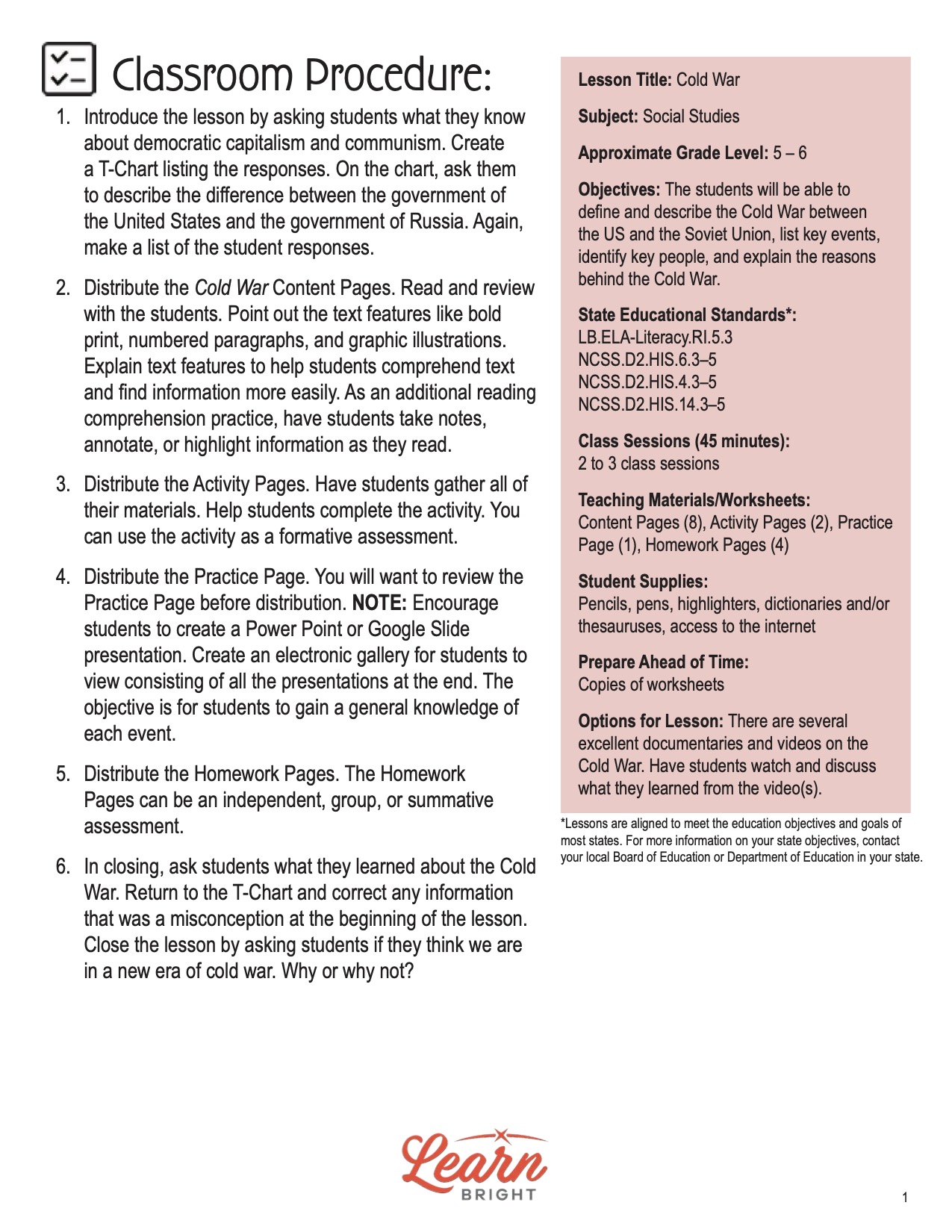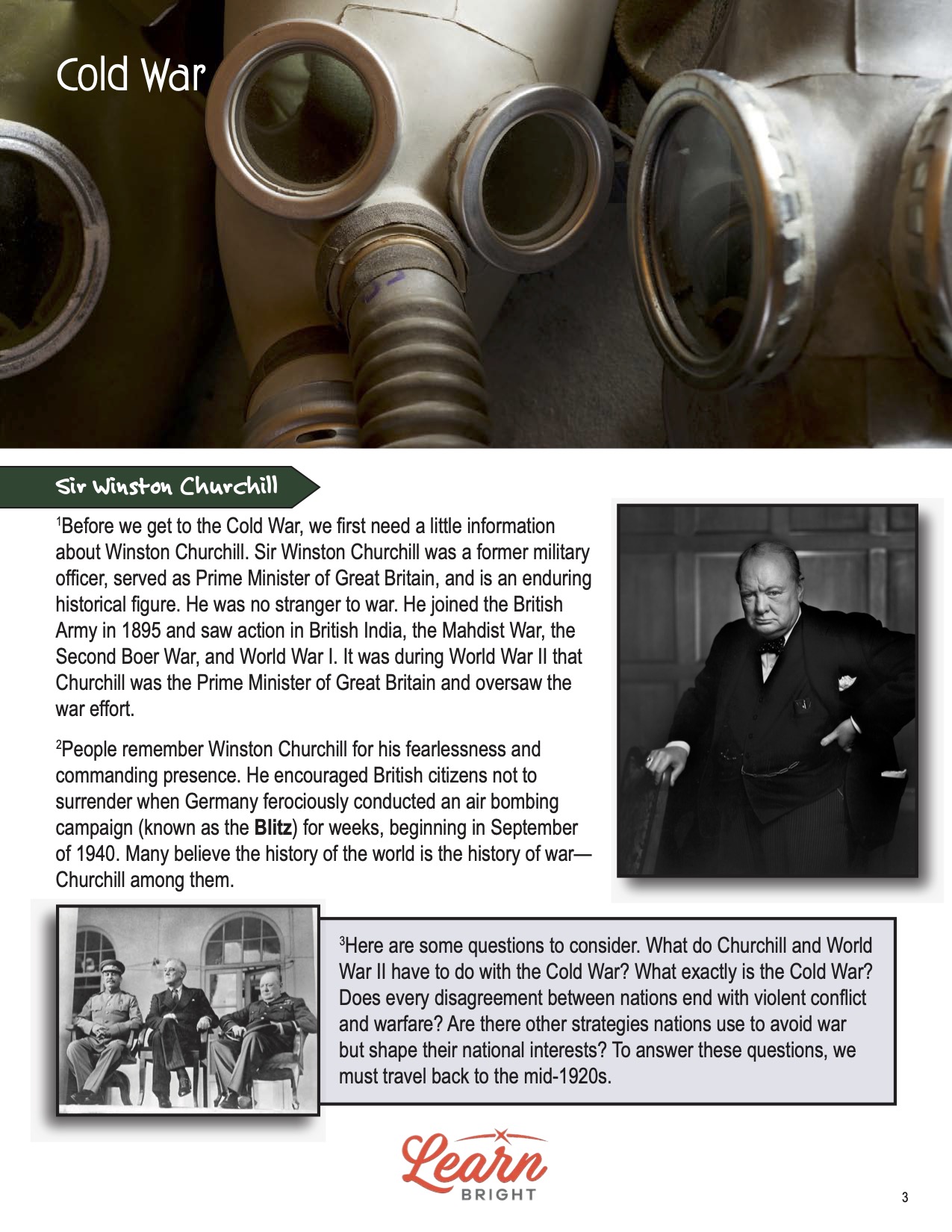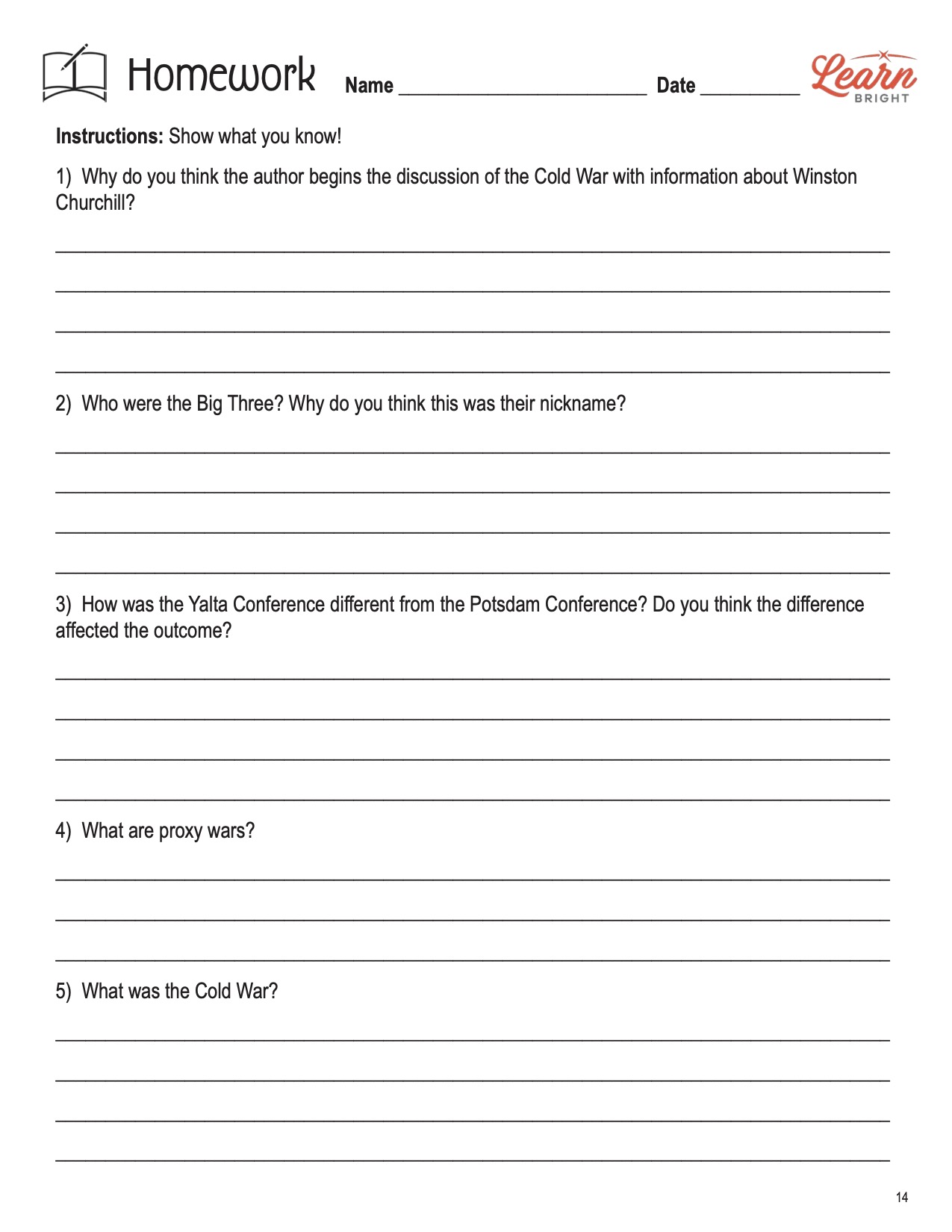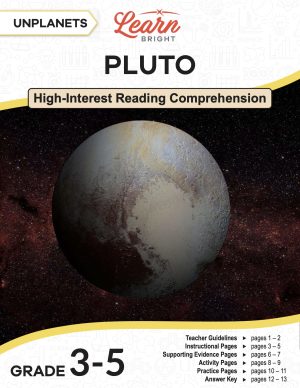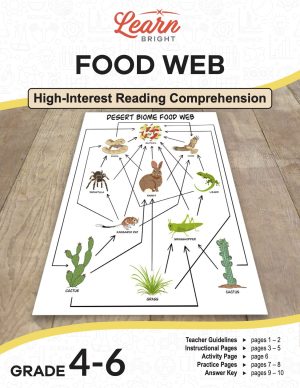Description
What our Cold War lesson plan includes
Lesson Objectives and Overview: Cold War introduces students to this interesting “battle” between America and the Soviet Union between 1945 and 1990. The students will be able to define and describe the Cold War between the US and the Soviet Union, list key events, identify key people, and explain the reasons behind the conflict. This lesson is for students in 5th grade and 6th grade.
Classroom Procedure
Every lesson plan provides you with a classroom procedure page that outlines a step-by-step guide to follow. You do not have to follow the guide exactly. The guide helps you organize the lesson and details when to hand out worksheets. It also lists information in the orange box that you might find useful. You will find the lesson objectives, state standards, and number of class sessions the lesson should take to complete in this area. In addition, it describes the supplies you will need as well as what and how you need to prepare beforehand.
Options for Lesson
Included with this lesson is an “Options for Lesson” section that lists suggestions for activities to add to the lesson or substitutions for the ones already in the lesson. There are several excellent documentaries and videos on the Cold War. Have students watch and discuss what they learned from the video(s).
Teacher Notes
The teacher notes page of the Cold War lesson plan includes a paragraph with additional guidelines and things to think about as you begin to plan your lesson. This page also includes lines that you can use to add your own notes as you’re preparing for this lesson.
COLD WAR LESSON PLAN CONTENT PAGES
Sir Winston Churchill
The Cold War lesson plan includes eight content pages. Before we get to the Cold War, we first need a little information about Winston Churchill. Sir Winston Churchill was a former military officer, served as Prime Minister of Great Britain, and is an enduring historical figure. He was no stranger to war. He joined the British Army in 1895 and saw action in British India, the Mahdist War, the Second Boer War, and World War I. It was during World War II that Churchill was the Prime Minister of Great Britain and oversaw the war effort.
People remember Winston Churchill for his fearlessness and commanding presence. He encouraged British citizens not to surrender when Germany ferociously conducted an air bombing campaign (known as the Blitz) for weeks, beginning in September of 1940. Many believe the history of the world is the history of war—Churchill among them.
Here are some questions to consider. What do Churchill and World War II have to do with the Cold War? What exactly is the Cold War? Does every disagreement between nations end with violent conflict and warfare? Are there other strategies nations use to avoid war but shape their national interests? To answer these questions, we must travel back to the mid-1920s.
Historical Context for Cold War
World War I ended in 1918. It resulted in dramatic and nearly unfathomable changes in Europe. Many of these dramatic events shaped the 20th century. Several major empires collapsed, creating new nations. European borders were redrawn. The United States became recognized as a global power. The emergence of communism in Russia following the Bolshevik Revolution ushered in European social and economic upheaval. The twenties became known as the Roaring Twenties because it was a period of significant economic prosperity, social change, and a vibrant cultural scene in the United States and Europe.
The trauma of World War I gave way to excitement and optimism for the future. Unfortunately, the Roaring Twenties faltered, and by 1929, the global economy collapsed, plunging the world into the Great Depression. Millions were left unemployed and homeless, with inflation soaring and desperation mounting. In Europe, charismatic leaders emerged who promised to fix the economy and restore Europe to its former glory. Desperate to relieve their economic misery, the populace turned to these leaders, who swiftly took complete control of European governments.
Economic turmoil and the rise of fascism in Germany, Italy, and Spain fueled the start of World War II. Adolf Hitler and the Nazi Party led Germany. They sought to rebuild national pride and restore the German economy that Hitler believed was destroyed by the Versailles Treaty at the end of World War I. Meanwhile, Japan eyed the vast natural resources in Asia and invaded Manchuria in 1931 and China in 1937. Germany’s invasion of Austria and Czechoslovakia occurred over the following two years.
Avoiding war became an impossibility as Germany, Italy, and Japan aggressively leveraged their military strength to invade nearby nations. World War II began in Europe on September 1, 1939, when Germany invaded Poland. Great Britain and France responded by declaring war on Germany on September 3. The war between the Soviet Union (USSR) and Germany began on June 22, 1941, as Germans invaded its borders.
Allies and FDR
The USSR’s economic and political system (communism) was a competitor with Western systems (capitalism and democracy). Despite this, the Allies joined with the Soviets to defeat Germany.
Even though the Allies aligned against Nazi Germany and Hitler, America and Great Britain did not trust the USSR during the war. The USSR, under the rule of Joseph Stalin, believed the Americans intentionally allowed German soldiers to breach its borders. Germany’s invasion of Russia forced the Germans to expend military resources in defending multiple fronts. Soviet leaders believed Russia was sacrificed to protect friendly, pro-capitalism European democracies.
Americans were suspicious of Soviet communism. Soviet efforts to claim territory in Europe following Germany’s defeat fed into the belief that the USSR intended to expand communism across Europe. American leaders were concerned about Stalin’s harsh rule of the Soviet Union. However, American President Franklin Delano Roosevelt (FDR) had a different take. He thought world peace could be possible if nations had a place to air their grievances and work collaboratively.
During FDR’s first year as president in 1933, he took action to recognize the existence of the Soviet Union and normalize diplomatic relationships with its leaders. At the start of WWII in 1939, Roosevelt initially had no interest in involving the United States in what many considered a European war. It took Japan’s bombing of Pearl Harbor in 1941 for Roosevelt to take action.
Yalta Conference
In February 1945, President Roosevelt, Prime Minister Churchill, and Soviet Premier Stalin met in Yalta, a small town on the Crimean Peninsula. Historians refer to these men as the Big Three. During this meeting, they discussed the fate of defeated Germany and what would happen to the rest of Europe. They also talked about the Soviet entry in the war in the Pacific against Japan and the formation of the United Nations, among other issues.
While there, Roosevelt was ill, and many believe Stalin took advantage of the president’s declining health to press an aggressive communist agenda. (This and other actions led some historians to think Roosevelt was soft and naïve on Soviet intentions in Europe.) Believing he had a strong negotiating position, Stalin demanded a Soviet sphere of political influence in Eastern and Central Europe to buffer future invasions from European countries. Roosevelt wanted Stalin to join the United States in providing troops to invade Japan and permanently end the war. Roosevelt and a reluctant Churchill agreed to Stalin’s request.
Churchill took a hardline approach to Stalin at the conference, however, which may have taken Stalin by surprise. Churchill was faced with a takeover of Great Britain by Nazi Germany or the threat of the spread of communism. In the end, he chose to leverage military advantage over Germany with a Russian alliance during the war. By the end of the Yalta Conference, a compromise was reached. Once the war was close to the end, Churchill correctly surmised that a new enemy was sitting at the conference table—Soviet communism.
Agreements at the Yalta Conference
The Yalta Conference decided that Germany would split into four zones after World War II. The US, Britain, France, and the Soviet Union would control the zones. (They divided the capital city of Berlin in the same way.) The countries agreed to try Nazi leaders for war crimes. In a key win for Roosevelt, a new United Nations organization was created to help keep peace, and Russia agreed to help with Japan. Churchill pressed and got a promise from Stalin to allow free elections in Eastern European countries. But as Churchill forecasted, Stalin broke the promise before the ink had time to dry on the Yalta Conference agreements.
The last meeting of the Big Three happened in Potsdam in July of 1945. President Harry Truman had replaced Roosevelt at the meeting due to FDR’s death. And about halfway through the conference, Churchill lost his election for Prime Minister and Clement Atlee took his place. Roosevelt’s death and Churchill’s loss may have emboldened the Soviets to become more aggressive in Europe.
While at the conference, Truman casually mentioned to Stalin that the US had developed a weapon with incredible destructive capabilities. Soviet spies had infiltrated the Manhattan Project, where the bomb was being developed, and Stalin was no doubt aware of the bomb’s existence. He came to believe that Truman withheld the information about the bomb because Truman intended to check Soviet and communist expansion in Europe by using the newly developed nuclear bomb to coerce other countries into working with democracies.
Stalin’s Betrayal
The Cold War began with the end of the Yalta Conference and with Stalin reneging on the agreement to allow free and democratic elections. Poland, Czechoslovakia, Hungary, Romania, and Bulgaria were all supposed to be able to hold free elections. Instead, communist governments were established in these five countries. The USSR suppressed non-communist political parties or pro-democracies, and no democratic elections occurred.
Some historians believe the Cold War really started between the end of the First World War and the global chaos resulting from the Great Depression of 1929. But most historians and scholars believe that the Cold War began in 1945, at the end of the Yalta Conference. However, as with many things in history, historians don’t agree about exactly when the Cold War started or whether it ever ended.
What Is the Cold War?
The Cold War refers to the intense political, economic, and diplomatic rivalry between the United States and the Soviet Union after World War II. The conventional way we think of war—with engaged militaries, battlefields, loss of civilian life, and destruction—does not apply to the Cold War. During this time, the US and USSR never directly fought each other. Instead, they competed through diplomatic, economic, and political maneuvering, as well as espionage, or spying. Propaganda was also a tactic. Another was election interference or trying to influence an election outcome so that the new leaders might be more favorable to one side than the other.
There’s an easy way to remember what the Cold War represents. Think of how some historians summarize the period between the Yalta Conference in 1945 and the end of the Cold War with the collapse of the Soviet Union in 1991. The Cold War can be summarized by broad historical themes or significant events.
Historians generally agree that while many significant events marked the Cold War, the proliferation of nuclear weapons played a considerable role in prolonging the conflict between the US and USSR. The common thread in these events is that the two countries used the threat of nuclear war as an instrument of diplomacy or political influence.
A New Era of the Cold War
The fall of the Berlin Wall and the dissolution of the USSR marked the end of the Cold War. Many historians, however, dispute the idea that the Cold War has ended. They contend that the issue of containing the proliferation of nuclear weapons was a failure. The countries with nuclear weapons are USA, Russia, China, France, United Kingdom, Pakistan, India, Israel, North Korea, and Iran (possibly).
Notice the number of countries with nuclear capabilities that were part of the WWII coalition. Most concerning to global leaders is that new technology allows for the scientific capability to transfer atomic weapons to other countries. The fear is that a nation will sell its knowledge and increase the number of countries that have the ability to build weapons of mass destruction.
Modern historians believe we may have exited the 20th-century Cold War and entered a 21st-century Cold War. This is because we are entering a new and increasingly unstable era of geopolitics. The US, pro-Western Europe, China, and Russia all vie for power and influence like never before. Plus, rogue terrorists operate outside of the norms of international law.
In this new era of the Cold War, cyber attacks, artificial intelligence, drone technology, space, propaganda or disinformation spread through social media, and highly sophisticated weaponry are the latest battle fronts. The new iteration of the Cold War is eerily similar to the Cold War that dominated the last century. Will a new generation of leadership perceive the danger and find ways to avoid the horrors of war? Or will the world engage in World War III?
COLD WAR LESSON PLAN WORKSHEETS
The Cold War lesson plan includes three worksheets: an activity worksheet, a practice worksheet, and a homework assignment. You can refer to the guide on the classroom procedure page to determine when to hand out each worksheet.
FACTS AND THEMES ACTIVITY WORKSHEET
Students will work with a partner to complete the lesson activity. Each pair of students will cut out the description rectangles on the worksheet pages. They will then glue the descriptions under the label it best fits: key facts, significant events, or themes. There are six blank cards students can fill in themselves. For the significant events section, students should order the events chronologically.
JIGSAW COLD WAR STRATEGY PRACTICE WORKSHEET
For the practice worksheet, students will divide into groups and become experts at a specific topic. Groups will share what they learned with each other using the jigsaw strategy. The page lists 16 topics for students to choose from. You can also assign the topics yourself if you wish.
REVIEW HOMEWORK ASSIGNMENT
The homework assignment requires students to answer 10 questions related to the content they learned.
Worksheet Answer Keys
The Cold War lesson plan includes an answer key for the homework assignment. The correct responses are in red to make it easy to compare them to your students’ work. If you choose to administer the lesson pages to your students via PDF, you will need to save a new file that omits these pages. Otherwise, you can simply print out the applicable pages and keep these as reference for yourself when grading assignments.


